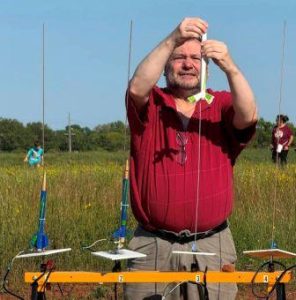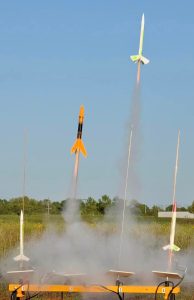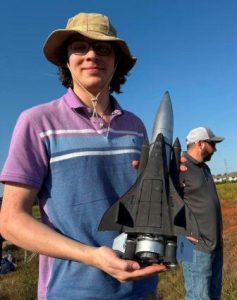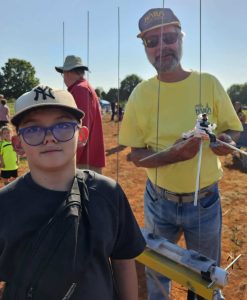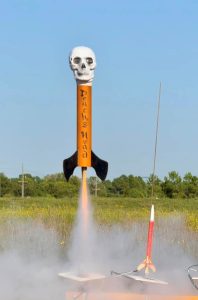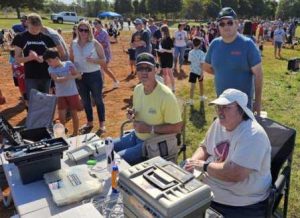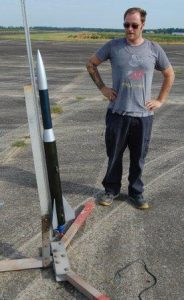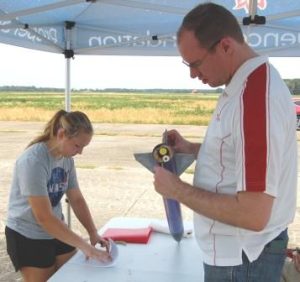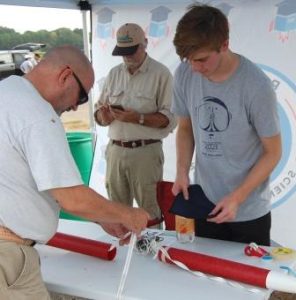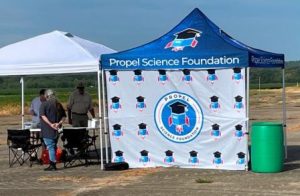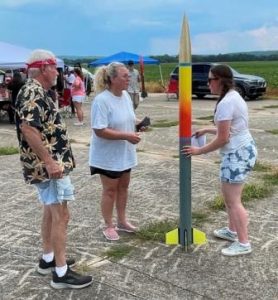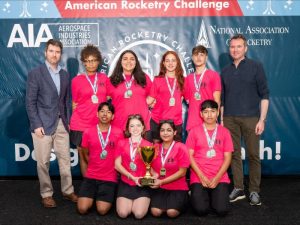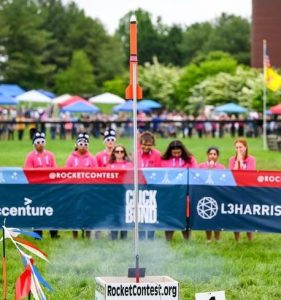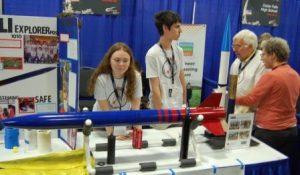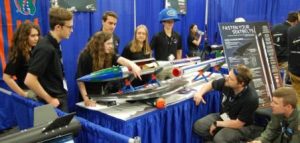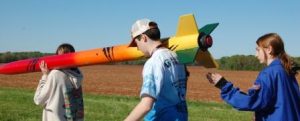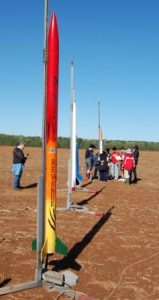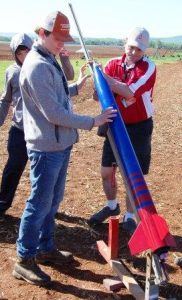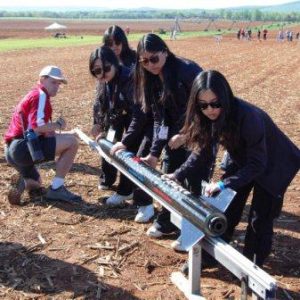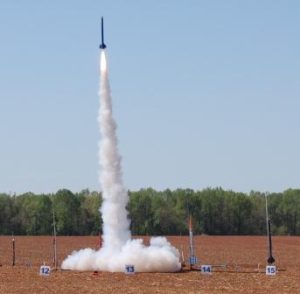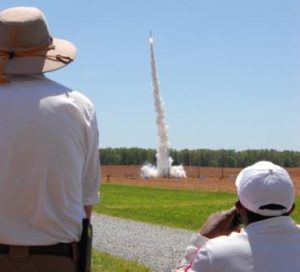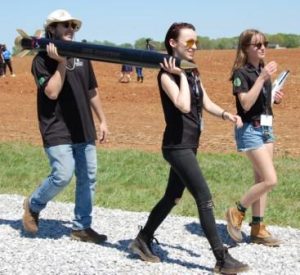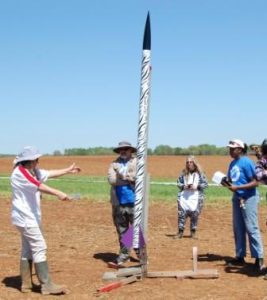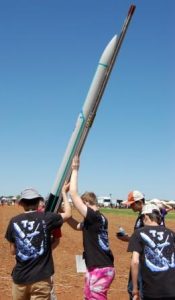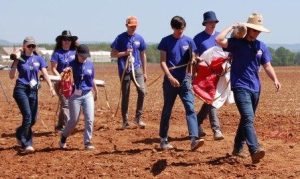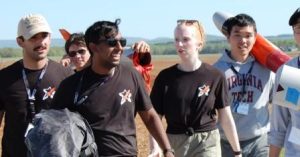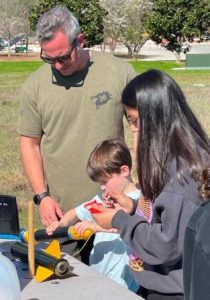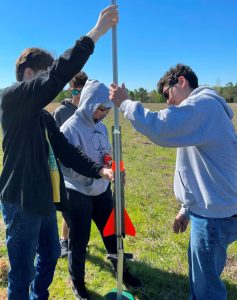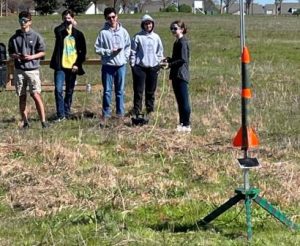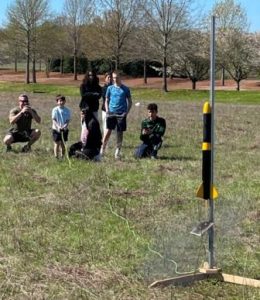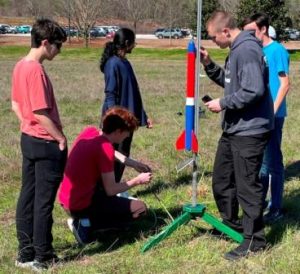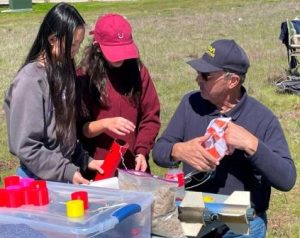The clear October twelfth sky was filled with Blue Origin rockets built by the employee families and launched by HARA. It was an active afternoon with about 180 flights, triple the number from the first family launch event last year. The Wizards, Vipers and Alphas on A motors had their share of misfires with kids learning how to correctly install ignitors, but all the rockets got launched and recovered. Club members brought and flew a few of their own models but they were mostly busy loading up the racks. Everybody had fun and we hope to do it again next year.
Courtland Ascends
The old Courtland airfield came alive again Saturday, Aug 31 when the Propel Science Foundation (PSF) hosted a HPR certification day for its students and mentors. HARA attended with range equipment and expertise to get 40 rockets launched. The flights were mostly H motors on L1 attempts and kept the inspection team busy checking motor retention, parachute packing and coupler tightness. Many of the cert flights were made by members of the 2024 ARC National Champion Tharptown team going to the next level of rocketry. Andrew Heath of PSF organized the event who was the mentor for the Tharptown ARC team and a member of the 2015 TARC Champion team.
Alabama ARC Team Second in World
National Champions from Alabama, the Tharptown High School’s rocketry team placed second in the International Rocketry Challenge at the Farnborough Air Show July 25, 2024. They competed against three teams total, from Japan, France and the United Kingdom which won first place. 
Tharptown High School math teacher Areanna Orozco said, “We are so thankful for the opportunity to represent the United States. I am so proud of every single student and all the hard work they have put in. This was the closest score between first and second, a 10 point difference.”
- First place (UK) 834 ft 43 second (14 pts)
- Second place (USA) 811 ft 39 sec (24 pts)
Orozco said 40 percent of the score at the international competition was based on the team making a presentation, something they practiced in front of an audience as part of their special day of Space and Rocket Center activities.
Franklin County’s Tharptown High School has sent a team to the national finals six times since the program started in 2018. THS has now placed in the top 10 four times, including a second-place finish in 2023.
HARA meeting postponed until July 11
Hi everyone!
Given that our normal meeting time falls on the 4th, we are postponing the HARA meeting until next Thursday, July 11. Don’t want to conflict with the Independence Day fireworks and cookouts!
Have a great 4th of July!
Alabama Captures 2024 National ARC Championship
Tharptown High School from Russellville, Alabama, won first place and earned the title of National Champion at the world’s largest rocketry competition, the American Rocketry Challenge, at The Plains, Virginia. Tharptown bested a record-breaking 922 teams that entered the competition at the start of the year and the top 100 teams competing at National Finals on Sunday, May 19, designing, building, and launching a model rocket with greater precision than any other team in the country.
Tharptown High School students will take home $20,000 and will represent the United States in the International Rocketry Challenge at the Farnborough Air Show, outside London, in July. Muscle Shoals High School came in fifth and won $8500. Huntsville’s John Paul II High School did not make the cut to the second round.
“We all work together as a team and come together to give input,” said Kylee Beard, Tharptown High School’s team captain. “We have one senior on our team, one sophomore, and the rest of us are juniors, so we’re looking forward to success in the years ahead.”
Tharptown High School has become a rocketry powerhouse, sending a team to the National Finals six times since the program started in 2018. Tharptown High School has now placed in the top 10 four times, including a second-place finish last year and tenth in 2022. The team is mentored by Andrew Heath, who was the team captain of the Russellville City Schools team that won the International Rocketry Challenge in 2015. Tharptown’s win marks the second Alabama and Russellville National ARC Championship.
The team’s victory follows months of preparation designing, building, and testing a rocket capable of meeting rigorous mission parameters set by the contest’s sponsors – the Aerospace Industries Association (AIA), National Association of Rocketry, and more than 20 industry partners. To qualify for the finals, each team designed, built, and launched a model rocket that safely carried one large hen egg to an altitude of 820 feet, stays airborne for between 43 and 46 seconds, and returns the rocket to the ground safely. At the National Finals, a Friday night coin flip determined that competing teams had to launch the rockets to 850 feet with a flight duration of 43-46 seconds in the first round of competition. The top 24 teams conducted a second launch that was required to reach 800 feet with a flight duration of 43-46 seconds. For the first time in ARC history Saturday was rained out and the launch was held the next day.
Now in its 22nd year, the American Rocketry Challenge has inspired nearly 95,000 middle and high school students to date to explore education and careers in STEM fields. “Twenty-one years ago, I walked on the same field as these competitors, preparing my home-built rocket for flight,” said NASA Astronaut Woody Hoburg present for the launch. “These competitions are catalysts for innovation, challenging young explorers to collaborate and get their hands dirty building a real flight vehicle. Congratulations to all the National Finalists for their ingenuity, hard work, and perseverance. These skills will serve students for years to come, as they embark on their careers and create technologies to solve the world’s biggest challenges.”
ARC 2024 Alabama Team Final Results
Place Team City State Flight 1 Flight 2 Total
1 Tharptown High School Russellville AL 3 1 4
2 Spring Grove School Spring Grove PA 5 2 7
3 AIAA Orange County Team 1 Irvine CA 7.32 6.72 14.04
4 Festus High School Festus MO 9 13 22
5 Muscle Shoals Team 1 Muscle Shoals AL 8.28 15.32 23.6
27 St. John Paul II Huntsville AL 23
38 Russellville High School Russellville AL 34.4
55 Lawrence County High School Moulton AL 51.64
70 Muscle Shoals Team 2 Muscle Shoals AL 73.56
98 Thompson High School Alabaster AL DNF
Seven Teams from Alabama ARC to Finals
Five ARC teams from north Alabama including one from Huntsville made the best scores in the country and are going to the finals. The schools are:
| Team Number | School or Organization | City |
| 24- 0811 | Thompson High School | Alabaster |
| 24- 0515 | St. John Paul II | Huntsville |
| 24- 0410 | Lawrence County High School | Moulton |
| 24- 0140 | Muscle Shoals High School Team 1 | Muscle Shoals |
| 24- 0418 | Muscle Shoals High School Team 2 | Muscle Shoals |
| 24- 0688 | Tharptown High School | Russellville |
| 24- 0473 | Russellville High School | Russellville |
Last year Tharptown High School from Russellville was second nationally with John Paul II High School of Huntsville third. This year they’re both going back along with Lawrence County High School that was also in the top hundred of 2023.
The finalists will compete on May 18 for the title of National Champion at The Plains, Virginia. In addition to the $100,000 prize pool, finalists will compete for the title of National Champion of the American Rocketry Challenge, which includes an all-expenses-paid trip to London for the International Rocketry Challenge in July.
To qualify for the National Finals participating teams designed, built, and launched model rockets that could safely carry a payload of one raw egg with a target flight duration of 43-46 seconds and an altitude of 820 feet. Cutoff score for top 100 was 32.12.
Total registered from the state for 2024 were 38 teams from 24 schools; 11 schools had multiple teams. We salute these teams and their work in rocketry.
| Thompson High School | Alabaster |
| Phillips High School | Bear Creek |
| Girl Scouts of North-Central Alabama | Birmingham |
| Cullman Area Technology Academy | Cullman |
| Central High School | Florence |
| Rogers High School | Florence |
| Hackleburg High School | Hackleburg |
| Haleyville City Schools | Haleyville |
| Alabama School of Cyber Technology and Engineering | Huntsville |
| St. John Paul II Catholic High School | Huntsville |
| Lincoln High School | Lincoln |
| Bob Jones High School | Madison |
| Alabama School of Mathematics and Science | Mobile |
| Lawrence County High School | Moulton |
| Muscle Shoals High School | Muscle Shoals |
| Phil Campbell High School | Phil Campbell |
| Russellville High School | Russellville |
| Tharptown High School | Russellville |
| Sylvania High School | Sylvania |
| West Morgan High School | Trinity |
| West Morgan Middle School | Trinity |
| Hewitt Trussville High School | Trussville |
| Wetumpka High School | Wetumpka |
| Winfield City High School | Winfield |
“L” L Rockets
The L is for fifty large rockets that roared aloft at NASA’s Student Launch Program April 13 in the culmination of a year of long work by the student teams. The weather was beautiful with a clear calm sky allowing the easy flight and recovery of big birds on big motors. With the manifest exceeding last year’s number of 48 rockets the range crew of HARA members and NAR dignataries had a long day (from 6am to 5pm.) All flights were made safely and most were very impressive. Results of the competition will be announced in another month.
mARCh MADNESS
The end of March means the end is coming of qualification attempts for the American Rocketry Challenge. Many teams were scrambling on the sunny days to get their eggloft flights scored and submitted. Here are some scenes of local action.
The March 23 launch is scrubbed!
Fellow rocketeers
Launch is scrubbed for March 9!
Unfortunately rain is predicted all day Friday and Saturday morning at our launch site and we are forced to scrub the launch. However, we have a scheduled another launch attempt for Saturday March 23. Hopefully we can get clear skies in 2 weeks.



